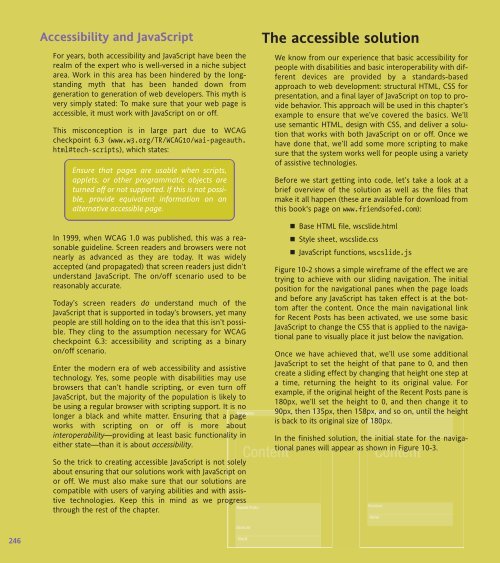WEB STANDARDS CREATIVITY
WEB STANDARDS CREATIVITY
WEB STANDARDS CREATIVITY
Create successful ePaper yourself
Turn your PDF publications into a flip-book with our unique Google optimized e-Paper software.
246<br />
Accessibility and JavaScript<br />
For years, both accessibility and JavaScript have been the<br />
realm of the expert who is well-versed in a niche subject<br />
area. Work in this area has been hindered by the longstanding<br />
myth that has been handed down from<br />
generation to generation of web developers. This myth is<br />
very simply stated: To make sure that your web page is<br />
accessible, it must work with JavaScript on or off.<br />
This misconception is in large part due to WCAG<br />
checkpoint 6.3 (www.w3.org/TR/WCAG10/wai-pageauth.<br />
html#tech-scripts), which states:<br />
Ensure that pages are usable when scripts,<br />
applets, or other programmatic objects are<br />
turned off or not supported. If this is not possible,<br />
provide equivalent information on an<br />
alternative accessible page.<br />
In 1999, when WCAG 1.0 was published, this was a reasonable<br />
guideline. Screen readers and browsers were not<br />
nearly as advanced as they are today. It was widely<br />
accepted (and propagated) that screen readers just didn’t<br />
understand JavaScript. The on/off scenario used to be<br />
reasonably accurate.<br />
Today’s screen readers do understand much of the<br />
JavaScript that is supported in today’s browsers, yet many<br />
people are still holding on to the idea that this isn’t possible.<br />
They cling to the assumption necessary for WCAG<br />
checkpoint 6.3: accessibility and scripting as a binary<br />
on/off scenario.<br />
Enter the modern era of web accessibility and assistive<br />
technology. Yes, some people with disabilities may use<br />
browsers that can’t handle scripting, or even turn off<br />
JavaScript, but the majority of the population is likely to<br />
be using a regular browser with scripting support. It is no<br />
longer a black and white matter. Ensuring that a page<br />
works with scripting on or off is more about<br />
interoperability—providing at least basic functionality in<br />
either state—than it is about accessibility.<br />
So the trick to creating accessible JavaScript is not solely<br />
about ensuring that our solutions work with JavaScript on<br />
or off. We must also make sure that our solutions are<br />
compatible with users of varying abilities and with assistive<br />
technologies. Keep this in mind as we progress<br />
through the rest of the chapter.<br />
The accessible solution<br />
We know from our experience that basic accessibility for<br />
people with disabilities and basic interoperability with different<br />
devices are provided by a standards-based<br />
approach to web development: structural HTML, CSS for<br />
presentation, and a final layer of JavaScript on top to provide<br />
behavior. This approach will be used in this chapter’s<br />
example to ensure that we’ve covered the basics. We’ll<br />
use semantic HTML, design with CSS, and deliver a solution<br />
that works with both JavaScript on or off. Once we<br />
have done that, we’ll add some more scripting to make<br />
sure that the system works well for people using a variety<br />
of assistive technologies.<br />
Before we start getting into code, let’s take a look at a<br />
brief overview of the solution as well as the files that<br />
make it all happen (these are available for download from<br />
this book's page on www.friendsofed.com):<br />
Base HTML file, wscslide.html<br />
Style sheet, wscslide.css<br />
JavaScript functions, wscslide.js<br />
Figure 10-2 shows a simple wireframe of the effect we are<br />
trying to achieve with our sliding navigation. The initial<br />
position for the navigational panes when the page loads<br />
and before any JavaScript has taken effect is at the bottom<br />
after the content. Once the main navigational link<br />
for Recent Posts has been activated, we use some basic<br />
JavaScript to change the CSS that is applied to the navigational<br />
pane to visually place it just below the navigation.<br />
Once we have achieved that, we’ll use some additional<br />
JavaScript to set the height of that pane to 0, and then<br />
create a sliding effect by changing that height one step at<br />
a time, returning the height to its original value. For<br />
example, if the original height of the Recent Posts pane is<br />
180px, we’ll set the height to 0, and then change it to<br />
90px, then 135px, then 158px, and so on, until the height<br />
is back to its original size of 180px.<br />
In the finished solution, the initial state for the navigational<br />
panes will appear as shown in Figure 10-3.















